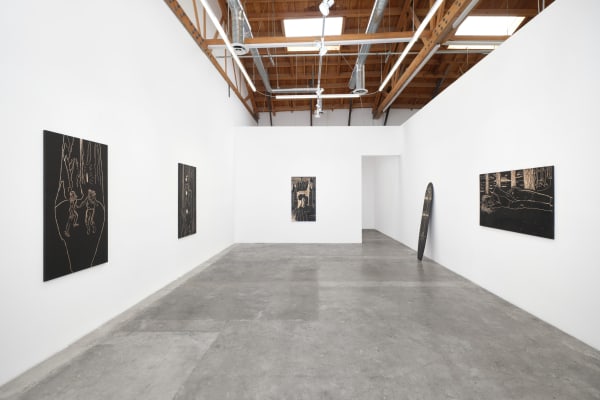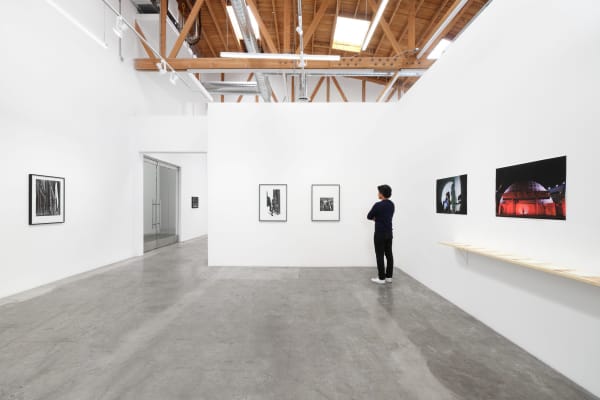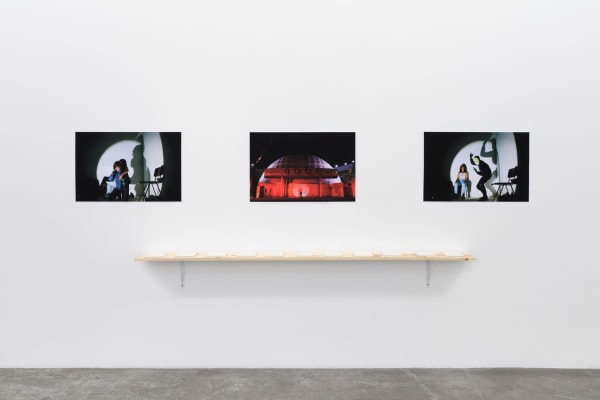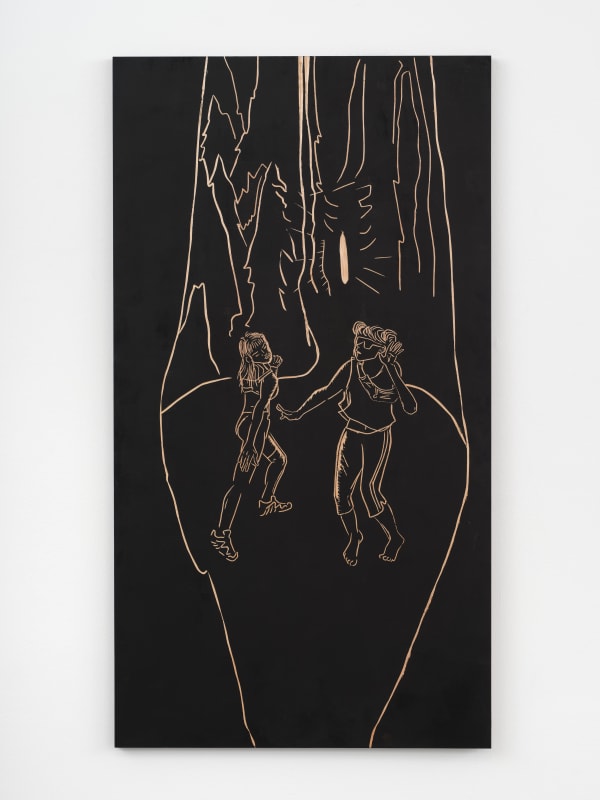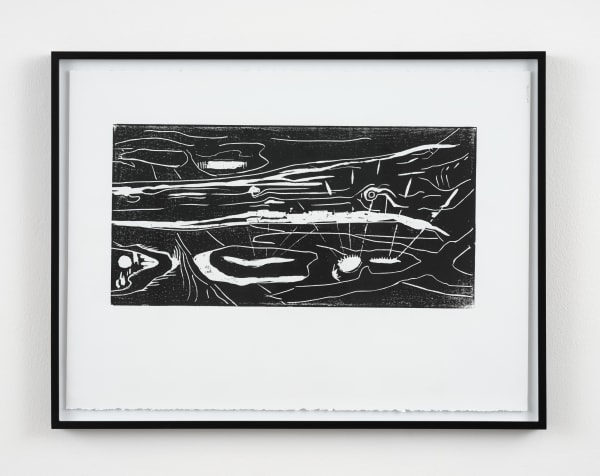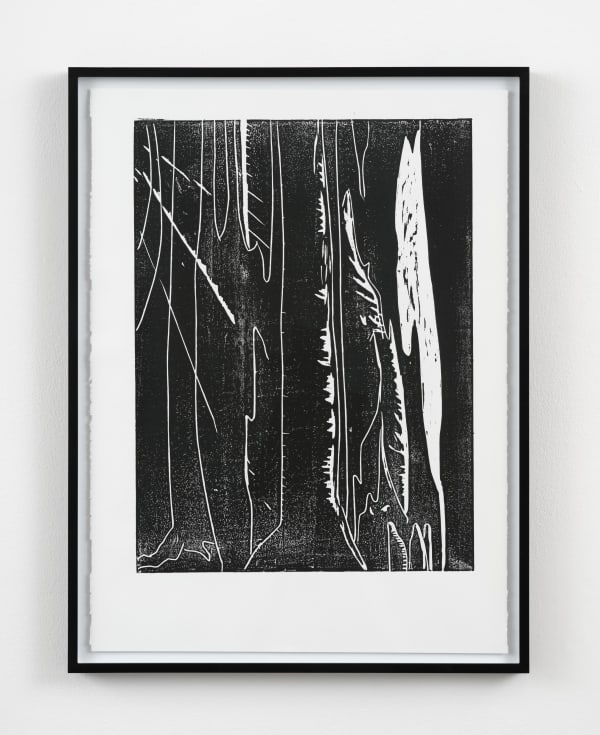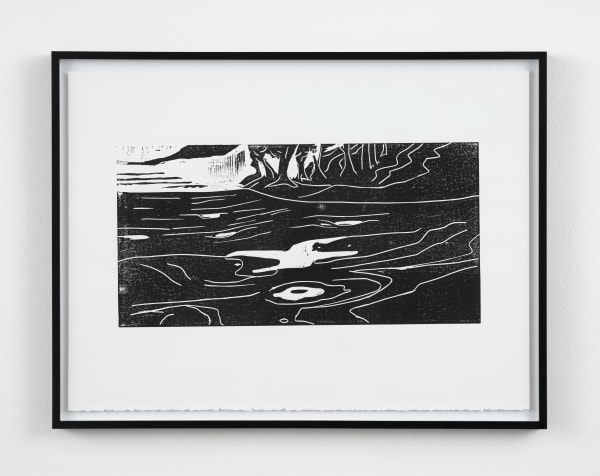Jordan Rountree: I Hear a New World
The house music sputters and glitches before settling into a choppy “chill.” The massive woodcuts – some with figures fading into trees, or Pierrot the clown altered from heartsick to mischievous – are also choppy: you sense their rough grain. During the performance, the cinema-quality, oversized video projection, flickers a nighttime Paris somehow empty of people, as if the citizens have sunk into some dark club; you feel the bass pulse and echo.
At heart, there is the text. “I Hear a New World” – the latest iteration of Jordan Rountree’s Chthonic Archive series – conjoins and elevates the above modes and images. The themes in Rountree’s story are chopped and evocative, iridescently clear but never plain. Its setting is scored to the rise of electronic music in 1999 Paris. The narrative includes: romance and sexual yearning; a sensitive boyhood groping with dissolving innocence; the impossible necessity of translating languages; the social scenes of young people that shape their (and everyone’s) identities and histories; a dreamworld that is a passage through time, lives, continents and dimensions; and a millenarian ego-matrix vaporized by love or drugs or the drug that is love.
“I believe in the power of art as a surface for the audience to bring meaning,” Rountree tells me in his studio. The meaning is tangible – never explicitly – in the textures of these disparate media. The artist’s hand is present in the woodcuts, pressing, carving, shaping a rough plane, once a tree yet still living. As a musician he also creates cuts, thick or smooth, using sampling techniques. The artist laces our conversation with allusions to Zeami Motokiyo, William Faulkner, Alfred Hitchcock and other practitioners of what Rountree calls “the striptease of art.” Their conceal/reveal aesthetic reminds me of Stanley Kubrick: “I don’t think writers or painters or filmmakers function because they have something they particularly want to say. They have something that they feel.”
Rountree feels most dynamic in his dance/text performance style, which he terms “Pop Noh,” a mode that updates traditional Japanese gestural elegance and the impassivity of masks by marrying them to today’s media dominion, fleeting images and darkening oppression. I first witnessed this in his “Beau Geste! 2” performance at Los Angeles’ O-Town House. Beneath his glacial movement, Rountree’s voice captured the precise tone of the late, amazing L.A. radio artist Joe Frank. It turns out that Joe Frank is yet one more living piece of L.A. that Rountree, who grew up and studied in Paris, reveres. The stage of “I Hear a New World” is 1999 Paris, but the world it hears is L.A. present and future, which impresses itself on the artist, just as the artist carves himself into art.
— Jack Skelley
Jordan Rountree (b.1990, Paris, France) began his visual art training at the Ateliers du Carrousel programme in the Louvre Museum in Paris, France. After studying life drawing and traditional artmaking techniques, his initiation into performance matured from working under the artist practices of Jasmin Blasco and Cyprien Gaillard; he later performed in Terence Koh’s “Adansonias” (2008) at Galerie Thaddaeus Ropac.
Rountree has since performed in national theaters and avant-garde spaces in Europe, including the Théâtre de la Bastille, the Pompidou Center in Paris, as well as the Ballhaus Ost in Berlin. He has also directed workshops at the Espace Van Gogh in Arles.
In 2015, Rountree established a studio practice in Los Angeles, where he uses Surrealist literary techniques to produce multidisciplinary works, primarily in the mediums of text, radio art, woodcuts, and performance. Jordan Rountree is based in Los Angeles and represented by Baert Gallery.
-
 Jordan RountreeScorched Earth II, 2025Ink on carved wood
Jordan RountreeScorched Earth II, 2025Ink on carved wood -
 Jordan RountreeTwo Revelers Dance in the Woods II, 2025Ink on carved wood
Jordan RountreeTwo Revelers Dance in the Woods II, 2025Ink on carved wood -
 Jordan RountreeSecret of Pierrot II, 2025Ink on carved wood
Jordan RountreeSecret of Pierrot II, 2025Ink on carved wood -
 Jordan RountreeA Figure Looks Over the Edge II, 2025Ink on carved wood
Jordan RountreeA Figure Looks Over the Edge II, 2025Ink on carved wood -
 Jordan RountreeParallel Ocean, 2025Ink on carved wood
Jordan RountreeParallel Ocean, 2025Ink on carved wood -
 Jordan RountreeA Figure Sleeps in the Woods, 2025Ink on carved wood
Jordan RountreeA Figure Sleeps in the Woods, 2025Ink on carved wood -
 Jordan RountreeI can tell it's you from your cigarette-scented fingers, 2025Archival inkjet print on matte rag
Jordan RountreeI can tell it's you from your cigarette-scented fingers, 2025Archival inkjet print on matte rag -
 Jordan RountreeRed light on the boarded-up Cinerama Dome, 2025Archival inkjet print on matte rag
Jordan RountreeRed light on the boarded-up Cinerama Dome, 2025Archival inkjet print on matte rag -
 Jordan RountreeThe babysitter and her boyfriend have devised a code, 2025Archival inkjet print on matte rag
Jordan RountreeThe babysitter and her boyfriend have devised a code, 2025Archival inkjet print on matte rag -
 Jordan RountreeA Community (a Strongman, a Child, a Fool, and a Scholar), 2025Woodcut on paper
Jordan RountreeA Community (a Strongman, a Child, a Fool, and a Scholar), 2025Woodcut on paper -
 Jordan RountreeSecret of Pierrot, 2025Woodcut on paper
Jordan RountreeSecret of Pierrot, 2025Woodcut on paper -
 Jordan RountreeCrocodile Among the Lotuses, 2025Woodcut on paper
Jordan RountreeCrocodile Among the Lotuses, 2025Woodcut on paper -
 Jordan RountreeThree Figures Follow A Distant Sound in the Woods, 2025Woodcut on paper
Jordan RountreeThree Figures Follow A Distant Sound in the Woods, 2025Woodcut on paper -
 Jordan RountreeA Figure Hides a Wound from a Young Person, 2025Woodcut on paper
Jordan RountreeA Figure Hides a Wound from a Young Person, 2025Woodcut on paper -
 Jordan RountreeA Monk Sits in the Woods, 2025Woodcut on paper
Jordan RountreeA Monk Sits in the Woods, 2025Woodcut on paper -
 Jordan RountreeFeeding Frenzy, 2025Woodcut on paper
Jordan RountreeFeeding Frenzy, 2025Woodcut on paper -
 Jordan RountreeA Figure Looks Over The Edge, 2025Woodcut on paper
Jordan RountreeA Figure Looks Over The Edge, 2025Woodcut on paper
